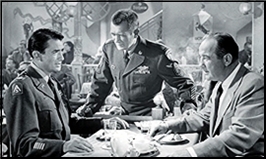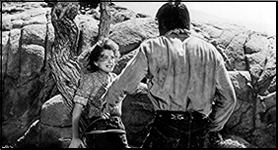REVIEWED BY DAN STUMPF:
LEE LEIGHTON (WAYNE D. OVERHOLSER) – Law Man. Ballentine, hardcover (H51) & paperback (#51), 1953. Ballantine U1040, paperback 1964. Axe, paperback, 1977. Ace/Charter, paperback, 1985. Jove, paperback, 1988. Winner of the first Western Writer’s Assocation Spur Award for Best Novel.

STAR IN THE DUST. Universal, 1956. John Agar, Mamie Van Doren, Richard Boone, Colleen Gray, Leif Erickson, Randy Stuart, Paul Fix, Harry Morgan, Kermit Maynard and Clint Eastwood. Screenplay by Oscar Brodney, from the novel by Lee Leighton. Produced by the redoubtable Albert Zugsmith. Directed by Charles Haas.
A taut film from a slack novel.
Leighton/Overholser’s book deals with twenty-four hours in the life of middle-aged Marshal Bill Worden: the last day in the life of convicted killer Ed Lake, scheduled to hang next morning. It also deals with a wide cast of characters, including:
Worden’s daughter Ellen, who is engaged to marry
George Ballard, who owns the biggest ranch in the valley and the local bank — and is therefore ipso facto a bad guy.
Nan Hogan, Ballard’s ex-mistress, now married to

Lew Hogan, a stubborn rancher who feels duty-bound to keep Lake from hanging
Rigdon, a fire-and-brimstone preacher who feels duty-bound to hang Lake himself
Mike MacNamara, Worden’s Deputy
Orval Jones, janitor and would-be deputy
Jeannie Mason, a fallen woman because of Ed Lake
plus assorted farmers, ranchers, cowhands, townsfolk and attendants to the court.
Leighton does a skillful job of setting all these folks at odds with each other: the ranchers out to save Lake, Ballard anxious to see that Lake doesn’t incriminate him, farmers egged on to lynching by Rigdon, Lake with his own plans for the future – and thankfully Leighton takes care to remind the reader who everyone is from time to time. He also works things to a convincing resolution, one that seems to grow from the characters themselves.

The problem is that Leighton tends to tell us how they feel—repeatedly and at length — when he should just show us — and when things should be getting tense, they just get wordy. Worthy concept, weak execution.
Oscar Brodney’s script for Star in the Dust tightens things up considerably. For one thing, it starts at dawn on the day Lake (here named “Sam Hallâ€) is scheduled to die at sunset. And since this is a film, the internal monologues of the book get replaced by a few lines of dialogue.

That’s not all that gets replaced. Preacher Rigdon of the book is here a power-mad schoolteacher (I think I had him for English 101 in College) and middle-aged Marshal Bill Worden is now youngish Bill Jordan (John Agar) engaged to marry Ballard’s sister (Mamie Van Doren.)
Best of all, nasty Ed Lake in the book is now Sam Hall, played with savage sensitivity by Richard Boone, a year before Have Gun, Will Travel and in those days a character actor to be reckoned with. I suspect Brodney knew he was writing for Boone, and wrote the part to fit him. His Sam Hall is educated, self-aware, and dangerous to know, a character at once sympathetic and frightening.

With Boone as the lynch pin, Star in the Dust could have stopped right there, but producer Albert Zugsmith fills the movie with fine actors in choice parts. Leif Erickson radiates bluff duplicity as the scheming bad guy, slimy Robert Osterloh projects petty tyranny as the schoolmaster, while Paul Fix and James Gleason do a fine double-act as Agar’s deputy and the wanna-be janitor.

Star in the DustEven better, Colleen Gray and Randy Stuart play off each other perfectly as the women who loved well but unwisely. Stuart in particular carries a moving rueful aspect as Erickson’s cast-off mistress, now married to Henry Morgan, as the loyal-but-not-bright Lew Hogan (Years later, Stuart also played Morgan’s wife in the 1960s Dragnet teleseries.)
Best of all, Star in the Dust moves in a way the novel never did, filling eighty minutes with action under the fast-paced direction of Charles Haas.
And by the way, in his one scene, a skinny young contract player named Clint Eastwood is what is usually and charitably termed adequate.




